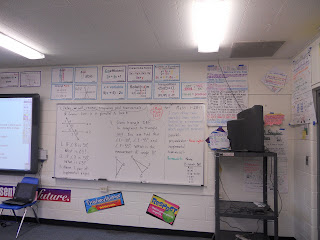Classroom setup can dramatically affect students' attitudes toward and habits of learning. Students need an environment that is organized, stimulating, and comfortable in order to learn effectively. Creating such an environment entails arranging a practical physical layout, supplying diverse materials and supplies, and encouraging students to have a sense of belonging and ownership.
There are 6 items that help create an effective classroom setting:
1. student exemplars displayed 2. print rich environment 3. availability of manipulatives
4. furniture allows for grouping 5. technology readily available 6. instructional material on walls
When you receive feedback done by an administrator or coach you can look in the Classroom Setting section to see what areas of strength you have and what areas need support. Below are examples of each.
Instructional Material on Walls:
objectives, information about the standards, examples/models, vocabulary, charts/graphs etc.
Technology Readily Available
Teacher and student able to access and use Activeboards, Elmo, Projector.
And for "older" technology, overhead projectors :-)
Furniture Allow for Grouping
Students will quickly be able to work cooperatively with their partners or team
Availability of Manipulatives
Students can quickly access materials need for learning; highlighters, rulers, colored pencils etc.
Print Rich Environment
Students can easily refer to text up on the walls, charts, graphs, books, exemplars to help them with learning
Student Exemplars Displayed
Examples of student work that meets standard




























